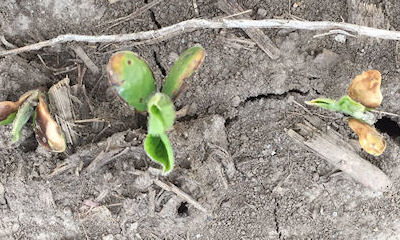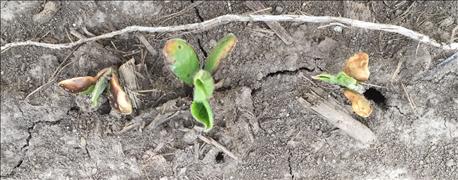
Whether or not you want to treat your soybean seed with the relatively new seed treatment, ILeVO, for sudden death syndrome, should be an economic decision. It should not be based on concern about the potential to see off-colors that resemble herbicide damage when the soybean cotyledons first come out of the ground. That's what experts are telling farmers.
Related: Weigh options for using Sudden Death Syndrome seed treatment

No big deal: Denny Cobb of Beck's says this visual damage, likely caused by ILeVO seed treatment, will not affect growth or yield. Don't confuse it with herbicide injury, he says. (Photo courtesy of Beck's)
Kiersten Wise, Purdue University Extension plant pathologist, says that if you have fields with history of Sudden Death Syndrome, this seed treatment can help. It is a relatively costly treatment, so it's wise to do budgets with expected soybean prices and potential yield benefits before making your decision, she indicates. It may be an option you want to use, especially in high-risk fields.
If you plant ILeVO treated seed, be aware that you might see a temporary side effect once the soybeans first emerge, notes Denny Cobb, an agronomist for Beck's in northern Indiana.
"From what we've seen, the effects are purely cosmetic and have no effect on subsequent plant growth and yield," Cobb says.
The problem is that the symptoms, often referred to as a halo effect on emerging cotyledons and young seedlings, can resemble herbicide injury, particularly the type of injury caused by PPO-type herbicides, he says.
If you're planting seed treated with ILeVO, take a look at the photo here, supplied by Cobb, to note what emerging seedlings can look like. It won't happen every time, but the potential is there. Discoloration in this picture will not affect plant growth, he assures. It's just a temporary reaction within the plant.
Sudden Death Syndrome can reoccur in fields with a history of the problem, Cobb agrees. Varieties of soybeans with more resistance than others are available.
Related: Keep SDS problems in mind when selecting soybean seed
Choose varieties with good resistance to SDS as one of the steps you take to control it, particularly if you know you are planting soybeans into fields in 2016 where it has occurred before.
About the Author(s)
You May Also Like




